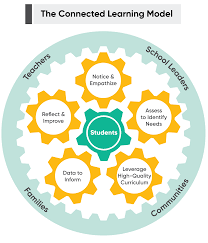The Importance of Quality Learning Materials
Learning materials play a crucial role in the educational journey of students and learners of all ages. Whether in a traditional classroom setting or through online platforms, the quality of learning materials can significantly impact the effectiveness of teaching and learning.
Engagement and Retention
Well-designed learning materials have the power to engage students and maintain their interest throughout the learning process. Visual aids, interactive exercises, and multimedia resources can make complex concepts more accessible and help students retain information more effectively.
Facilitating Understanding
Clear and concise learning materials are essential for facilitating understanding. Whether it’s textbooks, worksheets, videos, or online tutorials, well-organised content that is easy to follow can help students grasp new concepts and build upon their existing knowledge.
Promoting Independent Learning
Quality learning materials empower students to take control of their own learning journey. By providing well-structured resources that are accessible outside of the classroom, students can reinforce their understanding, practice new skills, and explore topics at their own pace.
Adaptability and Accessibility
Learning materials that are adaptable to different learning styles and abilities are essential for creating an inclusive educational environment. By incorporating various formats, such as audio recordings, visual diagrams, and text-based explanations, educators can cater to the diverse needs of their students.
The Role of Technology
In today’s digital age, technology has revolutionised the way we create and deliver learning materials. Interactive simulations, virtual reality experiences, online forums for discussion, and mobile apps offer innovative ways to engage learners and enhance their educational experience.
In conclusion, quality learning materials are fundamental for effective teaching and meaningful learning experiences. By investing in well-crafted resources that engage students, promote understanding, encourage independent learning, adapt to diverse needs, and leverage technology effectively, educators can empower learners to reach their full potential.
Understanding Learning Materials: Key Examples, Importance, and Essential Resources
- What are learning materials examples?
- What are the 7 instructional materials?
- What are learning materials Why are they important?
- Why are learning materials important?
- What are essential materials for learning?
- What is learning learning materials?
What are learning materials examples?
Learning materials encompass a wide range of resources that support and enhance the learning process. Examples of learning materials include textbooks, workbooks, educational videos, interactive online modules, flashcards, educational games, audio recordings, diagrams and charts, simulations, hands-on experiments or activities, and digital apps. These materials are designed to present information in various formats to cater to different learning styles and preferences, making the learning experience more engaging and effective for students of all ages.
What are the 7 instructional materials?
When considering instructional materials, it is essential to recognise a variety of resources that can enhance the teaching and learning process. The seven commonly identified types of instructional materials include textbooks, workbooks, visual aids such as charts and graphs, multimedia tools like videos and animations, manipulatives for hands-on learning experiences, computer software for interactive activities, and online resources for supplemental information and practice. By utilising these diverse instructional materials effectively, educators can cater to different learning styles and engage students in meaningful ways to facilitate their understanding and retention of knowledge.
What are learning materials Why are they important?
Learning materials are resources and tools used to facilitate learning and understanding in educational settings. They encompass a wide range of materials, including textbooks, worksheets, videos, interactive software, and online resources. Learning materials are essential for several reasons. They help to engage students by presenting information in various formats that cater to different learning styles. Quality learning materials also promote comprehension by breaking down complex concepts into manageable chunks and providing clear explanations. Moreover, they play a crucial role in promoting independent learning and allowing students to explore topics at their own pace. Overall, learning materials are important as they support effective teaching, enhance student engagement and retention, and contribute to a more inclusive and dynamic learning environment.
Why are learning materials important?
Learning materials are crucial in the realm of education for several reasons. They serve as the building blocks of knowledge transfer, providing students with the necessary tools to grasp new concepts, reinforce understanding, and engage with course material effectively. Quality learning materials play a vital role in facilitating learning experiences by enhancing comprehension, promoting retention of information, and catering to diverse learning styles. By offering structured and accessible resources, learning materials empower students to take ownership of their learning journey and foster independent study habits. In essence, the significance of learning materials lies in their ability to support and enrich the educational process, ultimately contributing to the overall success and development of learners.
What are essential materials for learning?
When considering essential materials for learning, it is important to prioritise resources that support comprehension, engagement, and retention. Textbooks, notebooks, and writing implements are fundamental tools for capturing and synthesising information. Visual aids such as diagrams, charts, and illustrations can enhance understanding of complex concepts. Additionally, access to digital resources like educational websites, online tutorials, and interactive learning platforms can provide dynamic and interactive learning experiences. Ultimately, a combination of traditional and modern learning materials tailored to individual learning styles can create a comprehensive educational environment conducive to effective learning outcomes.
What is learning learning materials?
Learning materials refer to the resources, tools, and content used to facilitate the teaching and learning process. These materials can take various forms, including textbooks, workbooks, videos, interactive software, online resources, and more. Essentially, learning materials are designed to support educators in delivering information and concepts effectively to students while providing learners with opportunities to engage with the content, practice new skills, and deepen their understanding. By utilising well-crafted learning materials that are engaging, informative, and accessible, educators can enhance the learning experience and help students achieve their educational goals more effectively.

